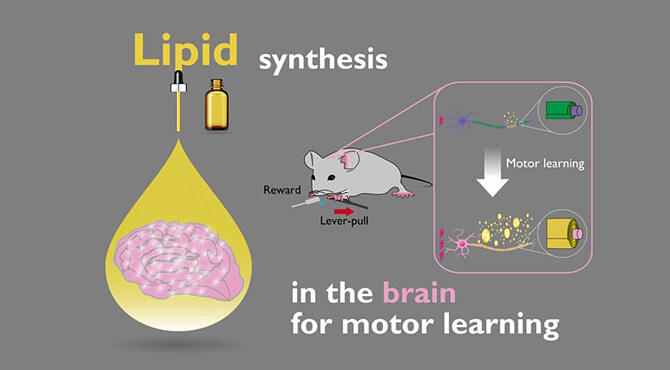A research group comprising Graduate Student Yuki Aoyama, Lecturer Daisuke Kato, and Professor Hiroaki Wake of the Department of Anatomy and Molecular Cell Biology at Nagoya University Graduate School of Medicine has focused its research on the myelin sheath which insulates the axon, the part of the neuron in the brain that is involved with outputting impulses. They have shown that changes in neuron activity, which are induced by motor learning, cause a change in the composition of lipids, which form part of the myelin sheath, and which are essential for motor learning. The research group has also clarified the details of the mechanism underlying this change in the lipid profile. The results of their study have been published in the July 20, 2023 electronic edition of GLIA.

Using a mouse lever-pull motor learning task, the group demonstrated that lipid synthesis in the white matter of the brain is essential for motor learning.
Provided by Nagoya University
The study investigated whether changes in the composition of lipids, which form a major part of the myelin sheath, are associated with motor learning. The myelin sheath is a layered structure that insulates the neuronal axon and is formed by oligodendrocytes, a type of glial cell in the brain. This sheath allows the rapid transmission of nerve signals, called action potentials, along the axon.
First, the group quantified neural activity associated with learning by combining a motor learning task in mice, using two-photon calcium imaging, to depict neural activity in the primary motor cortex (M1), a part of the brain involved in muscle control. Two-photon calcium imaging is a method that permits the visualization of neural activity in a live mouse brain by using a biological two-photon microscope. This method permits the visual observation of a depiction of neural activity by measuring the concentration of calcium ions as light intensity.
Next, the main lipid composition in the white matter immediately below the M1 was quantified using imaging mass spectrometry, which makes it possible to study the lipid composition in brain tissue slices while retaining information about spatial positions.
The results revealed that the expression of a particular lipid, sphingomyelin (SM), was upregulated in the early-to-mid phases of motor learning, while that of another lipid, galactosylceramide (GalCer), was upregulated during the mid-to-late phases. Furthermore, mice with higher learning performance and greater changes in neural activity associated with learning also exhibited more marked changes in the expression of these two lipids.
To determine the causal relationship between motor learning and changes in the myelin sheath lipid composition, motor learning was performed while the expression of galactosyltransferase (CGT), an enzyme that synthesizes GalCer, was specifically inhibited in oligodendrocytes. This resulted in the impairment of motor learning.
This study revealed that the lipid composition of the myelin sheath changes dynamically in response to nerve activity as part of the mechanism associated with enhanced motor learning. It also focused on changes in the lipid components of the myelin sheath during motor learning and revealed the contribution of these changes to motor learning in detail. Regulating the synthesis of specific lipids in the myelin sheath may lead to the identification of new therapeutic strategies for diseases associated with reduced white matter function. These findings may lead to therapeutic strategies for Alzheimer-type dementia and multiple sclerosis, diseases in which the pathology progresses with changes in the myelin sheath.
Wake stated, "This is the first study in the world to integrate imaging mass spectrometry analysis in all mouse samples in which neural activity was visualized using two-photon microscopy. It was a difficult study because it included a large amount of data, but we were able to compile it in this way. We hope it will serve as a useful reference for further research."
Journal Information
Publication: GLIA
Title: Regulation of lipid synthesis in myelin modulates neural activity and is required for motor learning
DOI: 10.1002/glia.24441
This article has been translated by JST with permission from The Science News Ltd. (https://sci-news.co.jp/). Unauthorized reproduction of the article and photographs is prohibited.




